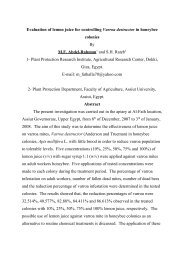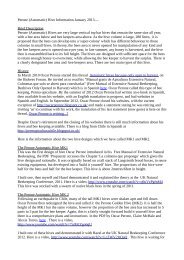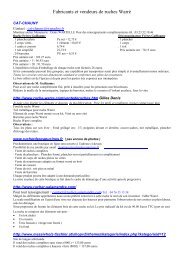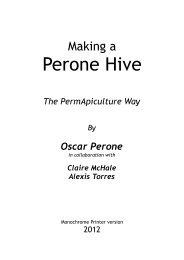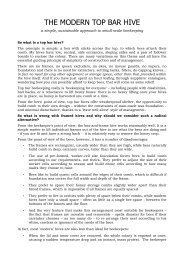Results of Research: Using Essential Oils for Honey Bee ... - BioBees
Results of Research: Using Essential Oils for Honey Bee ... - BioBees
Results of Research: Using Essential Oils for Honey Bee ... - BioBees
You also want an ePaper? Increase the reach of your titles
YUMPU automatically turns print PDFs into web optimized ePapers that Google loves.
Queens: A potential problem may be that queens on mating flights may have their pheromonemasked or may become somewhat disoriented by essential oils. We recommend that theessential oil treatments be removed from the hives when queen rearing and mating is takingplace. Care must be taken to avoid getting canola with essential oil directly onto the queen.Drones: We found that large numbers <strong>of</strong> drone cells provide protection to the varroa mites andare definitely the source <strong>of</strong> most breeding varroa mites. Consequently, we recommend that theamount <strong>of</strong> available drone cells be kept to a minimum; be sure to remove and replace old combcontaining lots <strong>of</strong> irregular drone cells. (See the literature <strong>for</strong> techniques using periodic droneremoval to reduce varroa mites).Comments on Varroatosis:There are two <strong>for</strong>ms <strong>of</strong> varroatosis (infestation <strong>of</strong> bee colonies by the varroa mite):1) Epidemic Varroatosis: This <strong>for</strong>m <strong>of</strong> varroatosis occurs when the disease spreadsuncontrolled through feral colonies, and/or through untreated apiaries in a large area. In this<strong>for</strong>m <strong>of</strong> the disease, "rapid development" <strong>of</strong> varroa mites is seen accompanied by the complex <strong>of</strong>ailments known as PMS (parasitic mite syndrome) or bee PMS (see papers by Shimanuki andHung), followed by sudden collapse and death <strong>of</strong> colonies. What is happening? Dying feralcolonies, or dying apiaries, send <strong>for</strong>th lost bees that are carrying large numbers <strong>of</strong> varroa mites.[Or, robber bees may be picking up large numbers <strong>of</strong> mites from dying feral colonies.] Thus a"queenright" colony is suddenly invaded by large numbers <strong>of</strong> phoretic, parasitic mites. Under"normal" conditions, the mites in a colony do not produce huge numbers in just one or twomonths; sudden increases in mite numbers are the result <strong>of</strong> mass influx <strong>of</strong> bees and mitesdeserting dying colonies. At the same time, the mites, coming from many diverse colonies, haveacquired many different pathogens: agents <strong>of</strong> sac brood, chalk brood, acute bee paralysis virus,kashmir virus, Egypt (de<strong>for</strong>med wing) virus, chronic bee paralysis, etc. The sudden appearanceand spread <strong>of</strong> these pathogens in a colony produces the syndrome called PMS. The colonybecomes very weak and unable to fend <strong>of</strong>f common pests such as wax moth, yellow jackets,etc., and the colony rapidly dwindles and then dies. Epidemic varroatosis was spread intovarious centers throughout the U.S. by migratory beekeepers, who were not aware <strong>of</strong> the degree<strong>of</strong> mite infestations nor <strong>of</strong> the various pathogens being transmitted. This epidemic varroatosishas thus spread throughout the U.S. in a series <strong>of</strong> expanding circles in nearly every state; thedisease reached Bob Noel’s colonies in summer 1995, when he began his research withessential oils. The most dramatic results <strong>of</strong> effective research will be evident when applied tocolonies suffering from epidemic varroatosis.2) Chronic Varroatosis: Once the epidemic has passed (as shown by the loss <strong>of</strong> all feralcolonies and the loss <strong>of</strong> all colonies in apiaries that were not treated), the varroatosis will take its"normal" chronic <strong>for</strong>m: much slower rate <strong>of</strong> development <strong>of</strong> mite populations in hives, which if leftuntreated, will eventually succumb in 3 or 4 seasons. Also, very few <strong>of</strong> the other virus diseaseswill be seen, which produced the PMS symptoms described above. Treatments using Apistan,<strong>for</strong>mic acid, etc., will prevent the mites from overwhelming colonies. Thus, here in the U.S.,beekeepers will enter the phase that the Europeans have been experiencing <strong>for</strong> the past severalyears. This milder <strong>for</strong>m <strong>of</strong> varroatosis causes some beekeepers to erroneously believe thatvarroatosis is not such a severe pest <strong>of</strong> honey bees, and that the terrible scourge that decimatedbee colonies must have been due to other causes. Despite its less severe expression, chronicvarroatosis is an insidious disease capable <strong>of</strong> the eventual demise <strong>of</strong> all European <strong>Honey</strong> <strong>Bee</strong>Colonies.






